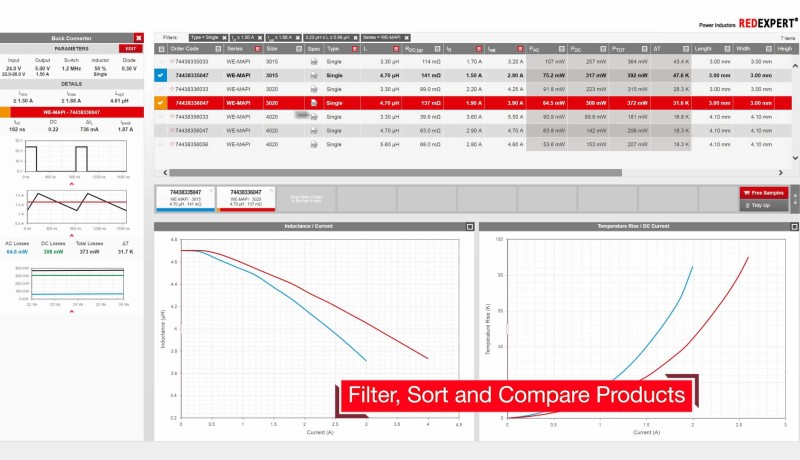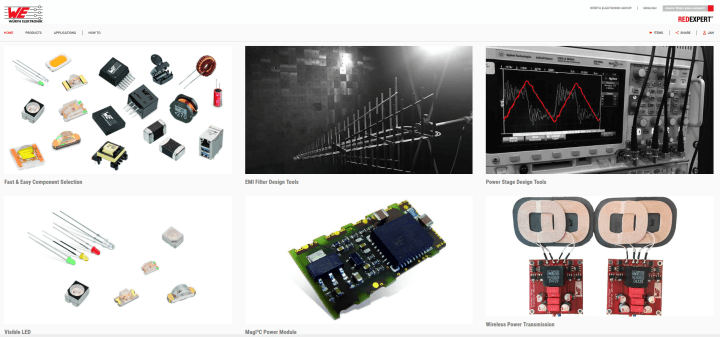Review: Würth Elektronik Red Expert
April 19, 2018
on
on

The current energy transition times we are going through must be one of the main reasons for analogue electronic circuit design to flourish again after decades of neglect, hiding in the shadow of the mighty microcontroller. Today, with electrical vehicles and solar panels all around us it’s no wonder young engineers need to find ways for every milliwatt of power generated by whatever clever physics process, to end up in the load at affordable cost to the user. Losses, spillage and pure waste as seen with conventional energy carriers like gas and carbon fuels are unacceptable for good reasons. Today it makes sense to squeeze the last percent of efficiency out of a switch-mode power supply — after all there are hundreds of millions of these things around accounting for tonnes of CO2 and a lot of EMI.
Along with increasing levels of “analogue talk” in the labs I was happy to hear a motto again from the old days of electronics: “your circuit is as good as its power supply”. Unfortunately, the AC power supply in particular is one of the least appealing circuits to study let alone develop, build, optimize and hopefully sell on the market. After all, this is electronics, right? Not electrical engineering, and there’s always 230 V or so on the wall outlet. True, but In practice much DC to AC conversion and vice versa will remain necessary in the coming years, and that is one of the key points covered by Würth Elektronik’s “Red Expert” online product.
Online and graphical
Registering to Red Expert’s free edition at https://www.we-online.com/redexpert/ follows the usual order of completing a signup form and waiting for a confirmation email. There is no “installation” of the product as everything is done online albeit not within a cloud or community environment.

I found Red Expert’s promotion/opening screen slightly incoherent with its images of LEDs, a scope screen, a PCB and a yagi antenna, all of which I found hard to consider a group until I realised it’s the applications being shown rather than the now corny symbols and icons from electrical theory.
Along with increasing levels of “analogue talk” in the labs I was happy to hear a motto again from the old days of electronics: “your circuit is as good as its power supply”. Unfortunately, the AC power supply in particular is one of the least appealing circuits to study let alone develop, build, optimize and hopefully sell on the market. After all, this is electronics, right? Not electrical engineering, and there’s always 230 V or so on the wall outlet. True, but In practice much DC to AC conversion and vice versa will remain necessary in the coming years, and that is one of the key points covered by Würth Elektronik’s “Red Expert” online product.
This is not a textbook
The art of power supply design and optimisation builds on a fundamental knowledge of inductors and capacitors, which admittedly are not as ‘hot’ as the latest ARM microcontroller running Linux. Both L and C come with a set of equations many of today’s technology students will not be too happy to see, learn or indeed bother to look up in a textbook. Although Würth Elektronik have published some of the best-in-class books on the subject in their famous Trilogy series, they have wisely complemented paper with online through Red Expert. Much of what is found in the Trilogy books in terms of R-L-C and AC conversion theory is found back in Red Expert, but then livened up, in a more attractive form, interactive, and most of all, challenging!Online and graphical
Registering to Red Expert’s free edition at https://www.we-online.com/redexpert/ follows the usual order of completing a signup form and waiting for a confirmation email. There is no “installation” of the product as everything is done online albeit not within a cloud or community environment.

I found Red Expert’s promotion/opening screen slightly incoherent with its images of LEDs, a scope screen, a PCB and a yagi antenna, all of which I found hard to consider a group until I realised it’s the applications being shown rather than the now corny symbols and icons from electrical theory.
Read full article
Hide full article


Discussion (0 comments)